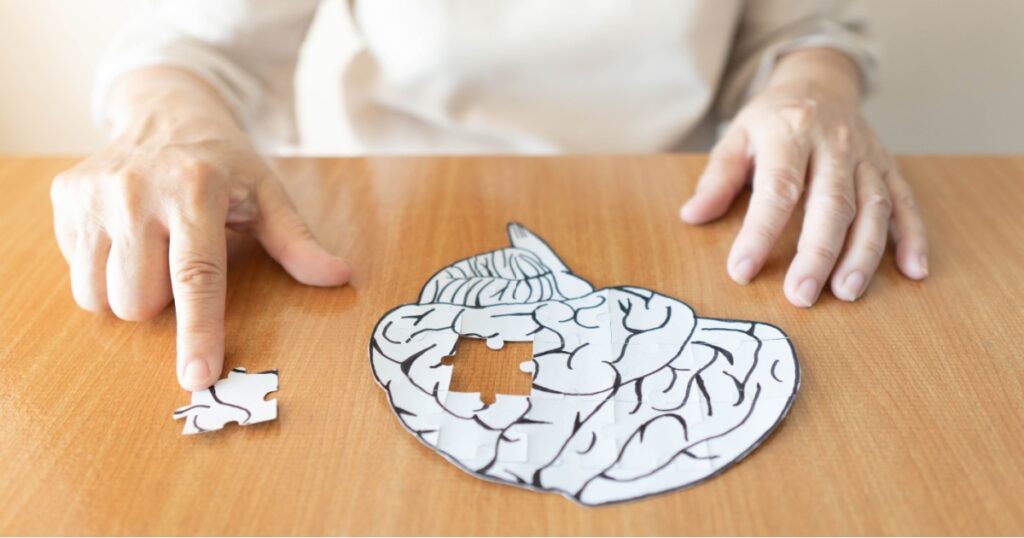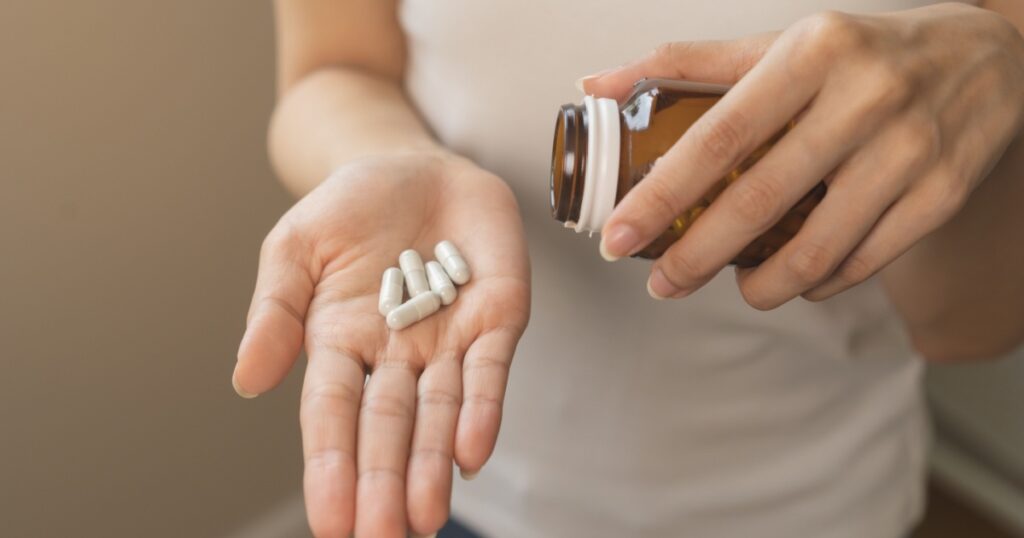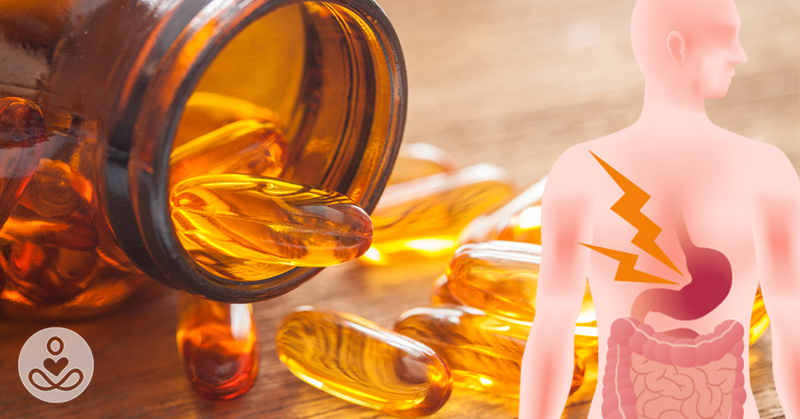Vitamin D is a vital nutrient that we consume and a hormone that our bodies produce. Vitamin D deficiency can be detrimental to your health and is linked to several conditions. As a fat-soluble vitamin, it has been widely recognized for facilitating the absorption and retention of calcium and phosphorus, essential components for building solid bones (Ellison & Moran, 2021). Our skin is the primary source of vitamin D production in the body. The process requires exposure to UV rays from sunlight to produce vitamin D3, which is then activated by the liver and kidneys (Bikle, 2011).
What is the recommended daily intake of vitamin D?

In the US and Canada, healthy adults and children ages 1 to 69 are recommended a daily intake of 600 IU (international units. Those 70 and older are recommended 800 IU daily. Osteoporosis Canada recommends 400 to 2,000 IU for adults at risk of osteoporosis. However, some individuals take up to 20 times the recommended dose of vitamin D to address medical conditions caused by its deficiency (University of Calgary, 2019).
Read More: Scientists Reveal New Findings About Older Adults Who Take Vitamin D
Dietary Reference Intakes for Vitamin D
| Age group | Recommended Dietary Allowance (RDA) per day | Tolerable Upper Intake Level (UL) per day |
|---|---|---|
| Infants 0-6 months | 400 IU (10 µg) | 1000 IU (25 µg) |
| Infants 7-12 months | 400 IU (10 µg) | 1500 IU (38 µg) |
| Children 1-3 years | 600 IU (15 µg) | 2500 IU (63 µg) |
| Children 4-8 years | 600 IU (15 µg) | 3000 IU (75 µg) |
| Children and Adults 9-70 years | 600 IU (15 µg) | 4000 IU (100 µg) |
| Adults > 70 years | 800 IU (20 µg) | 4000 IU (100 µg) |
| Pregnancy & Lactation | 600 IU (15 µg) | 4000 IU (100 µg) |
What are the typical indicators of vitamin D deficiency?

Most people with a vitamin D deficiency are asymptomatic, but if you’re tired, have bone or muscle pain, mood changes, or other symptoms, it could be a sign that something is wrong. Reasonable indications of vitamin D deficiency may include fatigue, poor sleep, depression, hair loss, weakness, loss of appetite, frequent illness, or pale skin (Nebraska Medicine UNIVERSITY HEALTH CENTER, n.d.). So, What are the health conditions and diseases associated with vitamin D deficiency?
1. Overweight and obesity

It has been observed that there is a negative correlation between vitamin D deficiency and metabolic states like insulin resistance and type 2 diabetes, as well as overweight and obesity. Early research revealed that individuals who were morbidly obese had poor vitamin D levels. In recent times, obesity and vitamin D deficiency have become widespread issues globally. Despite abundant evidence, there is still a debate in the scientific literature about whether obesity leads to vitamin D deficiency or vice versa (Pourshahidi, 2014).
2. Hypertension

Studies have shown that individuals with insufficient vitamin D levels may have increased arterial resistance, leading to high blood pressure (hypertension) due to elevated secondary parathyroid hormone (PTH) (Sambrook et al., 2006).
3. Depression

Research suggests a strong connection between vitamin D deficiency and the onset of various psychiatric and neurologic disorders. A comprehensive study investigated the relationship between vitamin D status, cognitive function, and mood in older adults to understand this connection further. The study aimed to gain insight into how vitamin D levels affect the mental, emotional, and physical aspects of aging and how this information can improve older individuals’ health and well-being (Wilkins et al., 2006).
4. Fibromyalgia

Research has examined whether there is a connection between vitamin D levels and fibromyalgia. Several studies have found that people with fibromyalgia are strongly matched to lower vitamin D levels than healthy individuals. However, it is still unclear what role vitamin D plays in the development of fibromyalgia; further research is needed (Ellis et al., 2018).
Read More: 8 Conditions That Might Warrant a Vitamin D Supplement, According to Experts
5. Osteoporosis

Vitamin D deficiency can hurt our bodies. It can cause increased levels of parathyroid hormone and lead to bone loss, resulting in weakened bones and fractures. In the long term, it can also cause mineralization defects, which may lead to a condition called osteomalacia. Furthermore, muscle weakness can occur, increasing the chance of falls and fractures (Lips & van Schoor, 2011). 6.
6. Alzheimer’s disease (aka, Type 3 Diabetes)

Studies have found lower volumes of vitamin D were linked to a higher risk of Alzheimer’s, which has been unofficially dubbed as type-3 diabetes, through various mechanisms (Shen & Ji, 2015).
7. Erectile dysfunction

It is interesting to note that epidemiological data have implied a correlation between vitamin D deficiency and erectile dysfunction. A review of the literature has shed light on the potential mechanisms by which vitamin D could impact the anatomy and physiology of the penis. The evidence suggests that vitamin D is crucial in maintaining healthy erectile function (Canguven & Al Malki, 2021).
It should also be noted that vitamin D deficiency has also been linked to a higher risk associated with different types of cancers, namely breast, prostate, and colon cancers. Based on the evidence, vitamin D may play a significant role in regulating cell growth and preventing the formation of abnormal cells. However, more research is needed to fully understand the relationship between vitamin D and cancer (Baptista et al., 2023).
The synergistic interplay between vitamin D and K2.

These two powerhouses work together to promote optimal health and wellness. Please take advantage of the excellent benefits they offer. The synergetic effect of vitamins D3 and K-2 is fat-soluble, and they play significant roles in calcium metabolism. Recent studies suggest vitamin D enhances vitamin K-2-dependent bone protein concentrations and induces bone formation (Koshihara & Hoshi, 1997) (Price & Baukol, 1981). So, How can I increase my intake of vitamin D?
Read More: Is Taking Vitamin D Without Vitamin K Harmful to Your Health?
Spending time outside in the sunshine

Remember that vitamin D is commonly known as the “sunshine vitamin” because it is one of the most effective sources of this nutrient. It has been proven that vitamin D from sun exposure circulates twice as long as vitamin D is obtained from a food or supplement source (Nair & Maseeh, n.d.).
Consume fatty fish and seafood.

Fatty fish and seafood are rich sources of vitamin D. A 3.5-ounce canned salmon contains 386 IU of vitamin D (Lu et al., 2007). Some of the best kinds of fish and seafood rich in vitamin D include:
- tuna
- mackerel
- oysters
- shrimp
- sardines
- anchovies
Source: (Mori, 2017)
Include egg yolks in your diet

Egg yolks are considered a natural source of vitamin D, but not all eggs are the same. Conventionally raised chickens produce eggs with only 2-5% of the RDI, while pasture-raised or free-range chickens can offer up to 4 times more vitamin D (Kühn et al., 2014a). There needs to be more awareness among Canadians and medical professionals regarding the safety of dietary cholesterol and egg yolk consumption. While some studies have suggested no harm in healthy individuals who consume eggs, it’s possible insufficient sample sizes limited these findings to detecting clinically significant increases in low-risk populations. Additionally, these studies have demonstrated that individuals who consume one egg per day and go on to develop diabetes may be at twice the risk compared to diabetic patients who consume less than one egg per week (Spence et al., 2010).
Take a supplement

People diagnosed with Celiac disease, individuals with a history of gastrointestinal tract surgery, those with naturally dark skin, people experiencing malabsorption issues, and those with limited sunlight exposure may benefit from taking a vitamin D supplement to maintain adequate levels. Vitamin D comes in two biological forms: Vitamin D2 (ergocalciferol), found in plants, and D3 (cholecalciferol), from animals. Research indicates that D3 may be more effective in boosting and sustaining overall vitamin D levels than D2 (Wilson et al., 2017).
Dr. Mike’s Top Vitamin D3 Supplement Picks

1. Naka Platinum Pro Emulsified Vitamin D 100ml
Emulsified vitamin D from Naka Platinum is an easy-to-take and gentle form of vitamin D that is safe for all ages. Naka’s emulsified vitamin D has superior bioavailability, helping the body absorb calcium and phosphorous. The micellized form of vitamin D is more water-soluble and suitable for people who have issues with fat digestion or have had their gall bladder removed. The emulsified vitamin D is more readily absorbed compared to other fat-soluble forms. Get it at The Health Shop for $29.98
2. NOW Vitamin D-3 Extra Strength 1,000 IU / drop Liquid, 30mL
NOW® Vitamin D-3 Liquid Extra Strength is highly absorbable and can quickly be taken directly from the dropper or added to beverages. Get it at The Health Shop for $19.17
3. NOW Vitamin D-3 & K2, 120 Caps
NOW® combines two nutrients extensively researched for their contribution to bone and tooth health. Vitamin D3 promotes calcium transport and absorption. Vitamin K is critical for forming a healthy, strong bone matrix. Vitamin K2 is a readily active and biologically available form of vitamin K. Get it at The Health Shop for $27.03
Takeaway

The significance of getting enough vitamin D daily cannot be overstated, as it is a crucial nutrient that many individuals across the globe do not consume enough of. Unfortunately, most people exhibit no visible indications or symptoms of vitamin D deficiency, making it challenging to identify. However, a deficiency in this nutrient can raise the risk of various severe health conditions over time. To ensure that you maintain healthy levels, please consult your family doctor or dietitian to evaluate your vitamin D levels and devise a plan to elevate them if necessary. This may help reduce your chances of developing many vitamin D deficiency illnesses while improving your overall health and well-being.
We regularly use The Health Shop’s Vitamin D3 which is better at raising your 25(OH)D levels than vitamin D2 and lasts longer in your body. Their vitamin D3 soft gels are delivered in a base of organic flaxseed oil. Because vitamin D is fat-soluble, it’s better absorbed in the presence of fat. Get your 30 day supply at The Health Shop for $16.75 while supplies last
Read More: Should Vitamin D and Magnesium Be Taken Together?
Written By: Dr. Michael Newman, DNM., Ph.D., HHP.
Doctor of Natural Medicine, Research Scientist and Board-Certified Holistic Health Practitioner
Dr. Mike holds a Master’s, Doctorate and Ph.D. in Quantum Natural Integrative Medicine and has been recognized by the International Association of Therapists and the American Association of Drugless Practitioners as an expert in the health field.
Dr. Mike practices Preventative Medicine and specializes in Stress Response Dysfunctions (SRD) and works with individuals who are struggling with stress, anxiety, depression, sleep dysregulation, digestive health issues and weight management.
Dr. Mike holds diplomas in Clinical and Holistic Nutrition, Cognitive Behavioral Therapy (CBT) and Master Neuro-Linguistic Programming (NLP).
This site contains product affiliate links. We may receive a commission if you make a purchase after clicking on one of these links.
Sources
- Baptista, S., Pereira Filho, R., Pereira, R., Milanezi, J., Assumpção, I., & Baptista, M. (2023). Evidence of the functions of vitamin d in pregnant women in covid-19: A systematic review. International Journal of Nutrology, 16(1). https://doi.org/10.54448/ijn23110
- Bikle, D. D. (2011). Vitamin d and the skin: Physiology and pathophysiology. Reviews in Endocrine and Metabolic Disorders, 13(1), 3–19. https://doi.org/10.1007/s11154-011-9194-0
- Canguven, O., & Al Malki, A. H. (2021). Vitamin d and male erectile function: An updated review. The World Journal of Men’s Health, 39(1), 31. https://doi.org/10.5534/wjmh.190151
- Ellis, S. D., Kelly, S. T., Shurlock, J. H., & Hepburn, A. N. (2018). The role of vitamin d testing and replacement in fibromyalgia: A systematic literature review. BMC Rheumatology, 2(1). https://doi.org/10.1186/s41927-018-0035-6
- Ellison, D. L., & Moran, H. R. (2021). Vitamin d. Nursing Clinics of North America, 56(1), 47–57. https://doi.org/10.1016/j.cnur.2020.10.004
- Koshihara, Y., & Hoshi, K. (1997). Vitamin k2 enhances osteocalcin accumulation in the extracellular matrix of human osteoblasts in vitro. Journal of Bone and Mineral Research, 12(3), 431–438. https://doi.org/10.1359/jbmr.1997.12.3.431
- Kühn, J., Schutkowski, A., Kluge, H., Hirche, F., & Stangl, G. I. (2014a). Free-range farming: A natural alternative to produce vitamin d-enriched eggs. Nutrition, 30(4), 481–484. https://doi.org/10.1016/j.nut.2013.10.002
- Kühn, J., Schutkowski, A., Kluge, H., Hirche, F., & Stangl, G. I. (2014b). Free-range farming: A natural alternative to produce vitamin d-enriched eggs. Nutrition, 30(4), 481–484. https://doi.org/10.1016/j.nut.2013.10.002
- Lips, P., & van Schoor, N. M. (2011). The effect of vitamin d on bone and osteoporosis. Best Practice & Research Clinical Endocrinology & Metabolism, 25(4), 585–591. https://doi.org/10.1016/j.beem.2011.05.002
- Lu, Z., Chen, T., Zhang, A., Persons, K., Kohn, N., Berkowitz, R., Martinello, S., & Holick, M. (2007). An evaluation of the vitamin d3 content in fish: Is the vitamin d content adequate to satisfy the dietary requirement for vitamin d? The Journal of Steroid Biochemistry and Molecular Biology, 103(3-5), 642–644. https://doi.org/10.1016/j.jsbmb.2006.12.010
- Mori, T. A. (2017). Marine omega-3 fatty acids in the prevention of cardiovascular disease. Fitoterapia, 123, 51–58. https://doi.org/10.1016/j.fitote.2017.09.015
- Nair, R., & Maseeh, A. (Apr. 2012). Vitamin D: The “sunshine” vitamin. National Library of Medicine, 3(2), 118–26. Retrieved March 2, 2024, from https://pubmed.ncbi.nlm.nih.gov/22629085/
- Nebraska Medicine UNIVERSITY HEALTH CENTER. (n.d.). 9 vitamin D deficiency symptoms (and 10 high vitamin D foods). Retrieved March 2, 2024, from https://health.unl.edu/9-vitamin-d-deficiency-symptoms-and-10-high-vitamin-d-foods#:~:text=Symptoms%20of%20vitamin%20D%20deficiency%20may%20include%3A&text=Bone%20pain%20or%20achiness,Muscle%20weakness
- Pourshahidi, L. (2014). Vitamin d and obesity: Current perspectives and future directions. Proceedings of the Nutrition Society, 74(2), 115–124. https://doi.org/10.1017/s0029665114001578
- Price, P. A., & Baukol, S. A. (1981). 1,25-dihydroxyvitamin d3 increases serum levels of the vitamin k-dependent bone protein. Biochemical and Biophysical Research Communications, 99(3), 928–935. https://doi.org/10.1016/0006-291x(81)91252-3
- Sambrook, P. N., Chen, C., March, L., Cameron, I. D., Cumming, R. G., Lord, S. R., Simpson, J. M., & Seibel, M. J. (2006). High bone turnover is an independent predictor of mortality in the frail elderly. Journal of Bone and Mineral Research, 21(4), 549–555. https://doi.org/10.1359/jbmr.060104
- Shen, L., & Ji, H.-F. (2015). Vitamin d deficiency is associated with increased risk of alzheimer’s disease and dementia: Evidence from meta-analysis. Nutrition Journal, 14(1). https://doi.org/10.1186/s12937-015-0063-7
- Spence, J., Jenkins, D., & Davignon, J. (2010). Dietary cholesterol and egg yolks: Not for patients at risk of vascular disease. Canadian Journal of Cardiology, 26(9), e336–e339. https://doi.org/10.1016/s0828-282x(10)70456-6
- University of Calgary. (2019, August 27). Vitamin D: How much is too much of a good thing? UNIVERSITY OF CALGARY UCALGARY NEWS. https://ucalgary.ca/news/vitamin-d-how-much-too-much-good-thing#:~:text=For%20normal%2C%20healthy%20adults%2C%20Health,2%2C000%20IU%20of%20vitamin%20D.
- Wilkins, C. H., Sheline, Y. I., Roe, C. M., Birge, S. J., & Morris, J. C. (2006). Vitamin d deficiency is associated with low mood and worse cognitive performance in older adults. The American Journal of Geriatric Psychiatry, 14(12), 1032–1040. https://doi.org/10.1097/01.jgp.0000240986.74642.7cWilson, L. R., Tripkovic, L., Hart, K. H., & Lanham-New, S. A. (2017). Vitamin d deficiency as a public health issue: Using vitamin d2or vitamin d3in future fortification strategies. Proceedings of the Nutrition Society, 76(3), 392–399. https://doi.org/10.1017/s0029665117000349
Disclaimer: This information is not intended to be a substitute for professional medical advice, diagnosis or treatment and is for information only. Always seek the advice of your physician or another qualified health provider with any questions about your medical condition and/or current medication. Do not disregard professional medical advice or delay seeking advice or treatment because of something you have read here.

